A beginner's guide to getting the most out of your digital marketing platform
What to Expect
Sitefinity Insight is a powerful tool that helps you measure, analyze, and optimize your online performance and customer journeys. It enables you to report on and improve how your visitors interact with your website and content. Whether you want to increase conversions, improve engagement, or personalize your digital experience, Sitefinity Insight can help you achieve your goals.
This guide is meant to be used by someone who is just getting familiar with Sitefinity Insight. If you follow the steps we outline here, you’ll gain confidence integrating the tool into your workflow and you’ll quickly come to appreciate how Sitefinity Insight can be used to make your job as a digital experience manager easier and more effective.
Here are the steps that we recommend following:
- Activate Sitefinity Insight
- Connect Sitefinity CMS and Sitefinity Insight
- Review core concepts: personas, visitors, contacts, conversions, touchpoints.
- Create a single persona
- Collect data & review
- Define your first conversion
- Optimize your touchpoints
We suggest you build a 2-week plan to advance through the steps above. In the first few days, you will get the system up and running and get oriented. A few days after that and you’ll discover that persona reports are an invaluable benefit to understanding audience segments. In the second week of your exploration, you’ll be well on your way to maximizing the effectiveness of your digital experiences. Conversion tracking will highlight where your content is having the most impact on getting your users to the desired destination. Boost your learning in the final day or two by adjusting your touchpoint tracking.

Let’s review each step, in detail.
Activate Sitefinity Insight
Sitefinity Insight is a cloud-based companion service for Sitefinity CMS customers with an active license, running a current version of the system. To use Sitefinity Insight, your very first step is to have an environment activated for your account. A quick note to your Progress Sitefinity Account Manager will take care of that for you. You can access Sitefinity Insight from the Administration menu in your Sitefinity CMS backend or from the Sitefinity Insight portal.
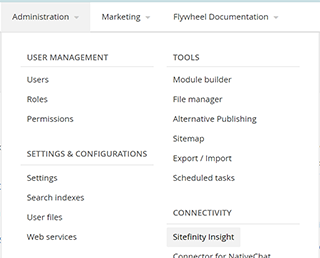
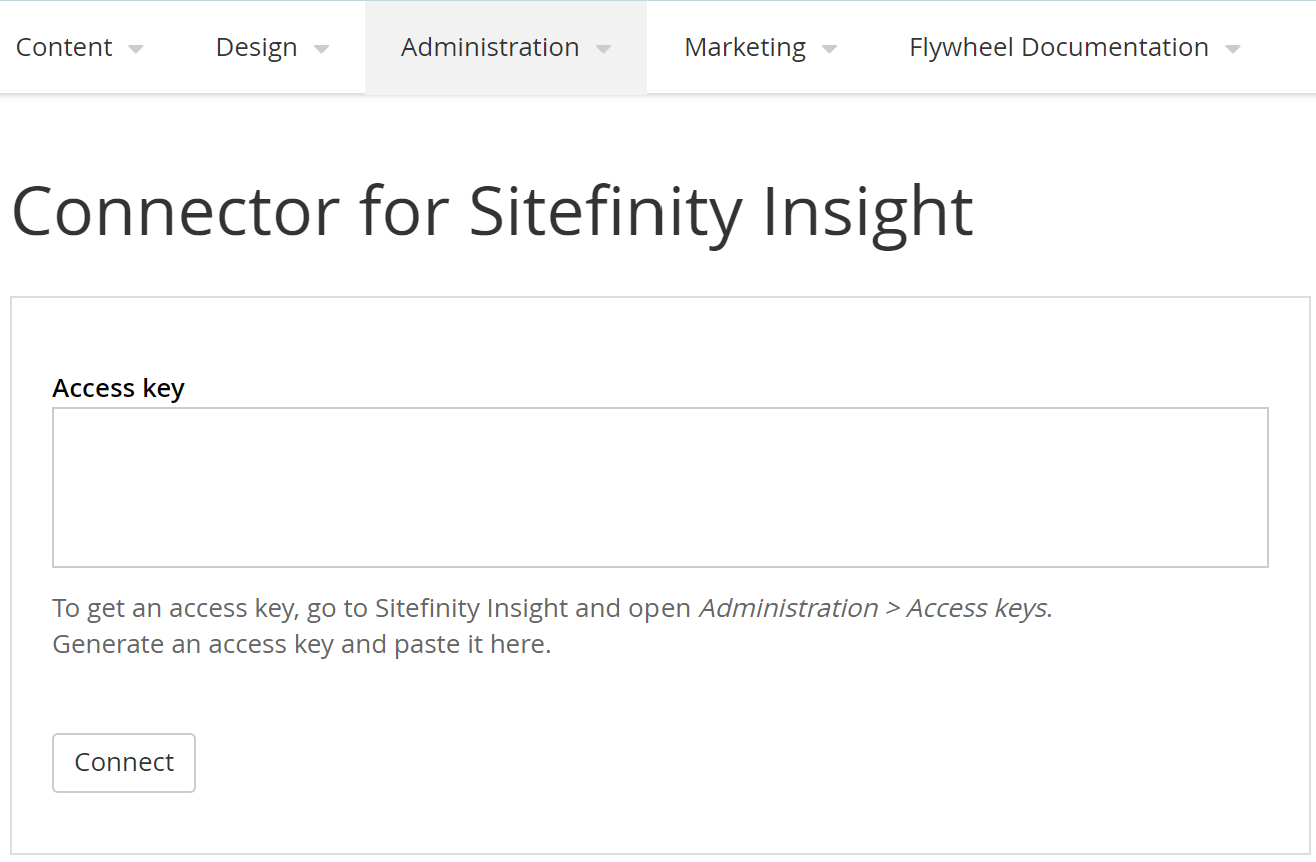
Connect Sitefinity CMS and Sitefinity Insight
To start collecting and analyzing data from your website, you need to connect Sitefinity CMS and Sitefinity Insight. This is a simple process that involves adding a tracking code to your website and configuring the data center and the data source in Sitefinity CMS. Login to your Sitefinity CMS backend and select Sitefinity Insight from the Administration menu. Follow the instructions here to connect your website to Sitefinity Insight.
Detailed Connection Instructions are found here:
Review Core Concepts
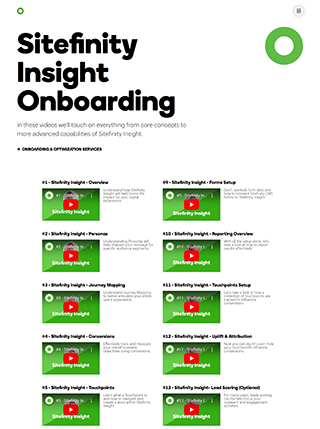
As the accomplished digital experience manager that you are, you’ll be familiar with these concepts, but let’s make sure we’re all thinking about these things the same way before you dive into the data and reports.
We have a series of shorts (each about 3 or 4 minutes) that also describes these core concepts:
Create a Single Persona
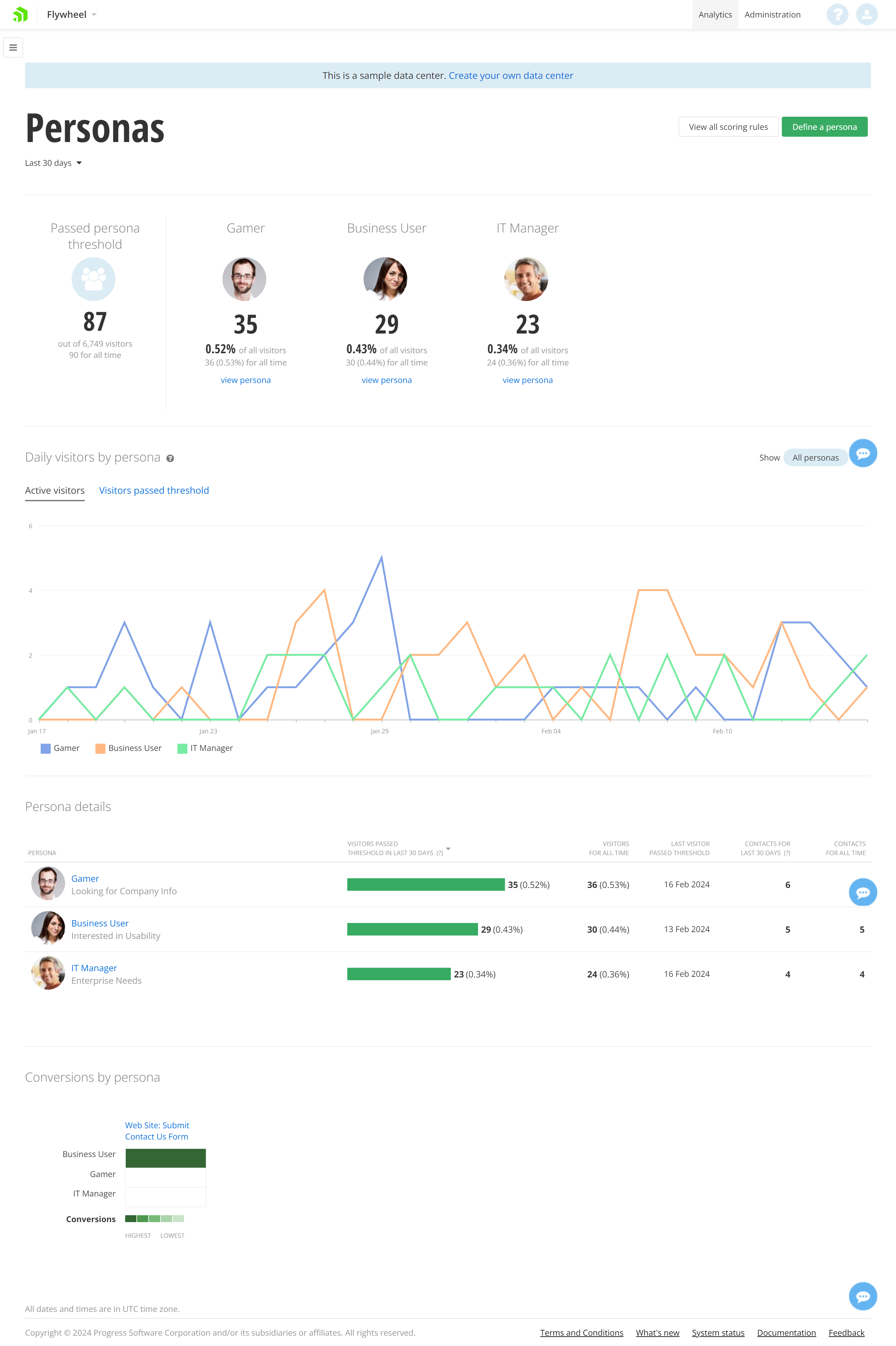
Sitefinity Insight is a dynamic and robust tool to help you uncover and measure the impact of your digital experience. To support your appreciation for everything the system can do, we recommend you build a single persona to start. Personas in Sitefinity Insight give you an automated, filtered view of how audience segments interact with your website and the rest of your digital experience.
Starting your adoption of Sitefinity Insight with the creation of a single persona helps discover the unique and powerful capabilities of the system. Exploring this data further will highlight how you can maximize the benefit of using Sitefinity Insight. For example, some organizations will prioritize creating more personas, while others will find greater value by closely tracking additional conversions.
With the intention of unlocking the value of Sitefinity Insight quickly, we suggest that the first persona you build is one that you can immediately identify. In the future you may work to build additional consensus for your personas and establish definitions that are more detailed. For the moment, though, start with a persona you can define yourself. For example, think of your largest customer segment. Or, perhaps you get a lot of employment inquiries or support calls that are routinely managed by your website. These are the types of visitors that stick to a specific area of your website and have a well-defined objective (making a purchase, applying for a job, opening a support ticket).
Login to Sitefinity Insight, click Personas in the left menu and then click the button labelled “Define a persona.”
When you create a new persona, you’re going to be asked to name it and to set a “persona threshold”. Classic marketing personas are given real pseudonyms (ie. “John Doe”), but for now use a name that describes the audience segment you have decided to track (ie. “Widget Purchasers” or “Employment Applicants”). As for the threshold value, set that to be 100. This will become clearer in a moment.
After creating the persona, the system needs to figure out which users belong to this group. This is done by defining a set of rules. Each rule assigns a value to specific visitor interaction. For example, a visitor might be given 10 points when they read a blog post and 25 points when they watch one of your videos. You decide the point values for each action. Once a visitor earns points to reach or exceed the persona threshold, the system will count them as a member of that persona.
For the purpose of our exercise today, create a few rules that will reasonably result in several users exceeding the 100 point threshold we set when creating our first persona.
We have a video that walks you through creating your first persona.
Go to our library of Insight Onboarding videos:
Collect & Review Data
After you have created your persona, you need to allow some time for Sitefinity Insight to collect data from your website. After a few days you can review your persona again to see initial results. Login to the Sitefinity Insight portal again and go back to the persona page. Here you’ll now find some data to explore:
- Overall traffic for that persona is shown in a graph at the top of the page
- Below the graph you can toggle through Touchpoints, Pages and some other details
You will likely notice that some of the reports are blank. We have not setup Conversions yet, and you likely don’t have any Contacts at this point. That’s ok – we’re getting to that shortly.
Define Your First Conversion
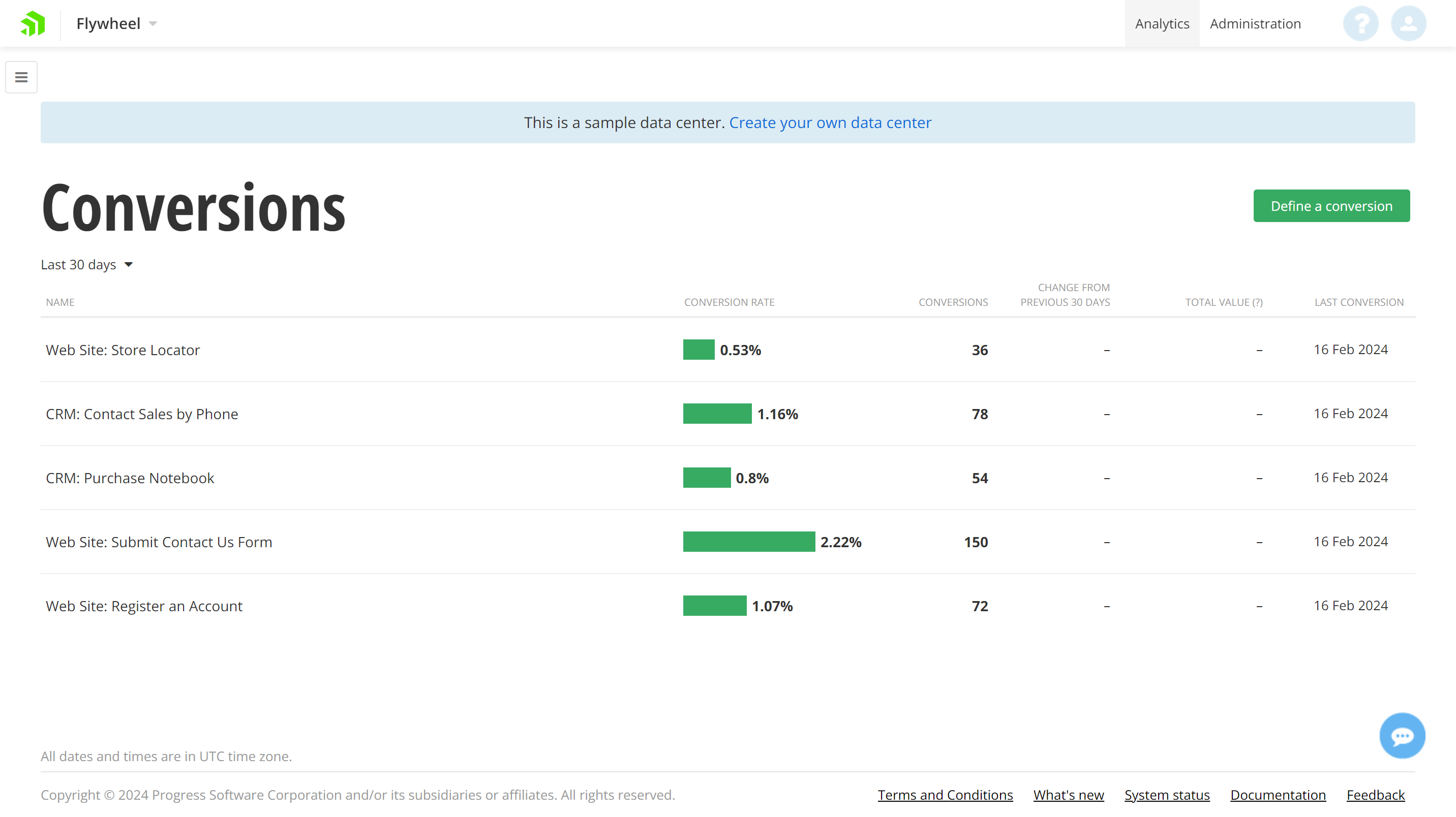 A conversion is a desired action that you want your visitors to take, such as downloading a resource, signing up for a newsletter, requesting a demo, making a purchase, etc. By defining and tracking conversions, you will be able to measure the impact of your website and content on your business goals and optimize them accordingly. With conversions setup, you’ll also get a clear understanding of how well each persona is engaging with your digital experience.
A conversion is a desired action that you want your visitors to take, such as downloading a resource, signing up for a newsletter, requesting a demo, making a purchase, etc. By defining and tracking conversions, you will be able to measure the impact of your website and content on your business goals and optimize them accordingly. With conversions setup, you’ll also get a clear understanding of how well each persona is engaging with your digital experience.
Stay in the context of the persona we’ve already created. Think about a specific desired outcome you want to see from that group. Then, proceed to setup your first conversion.
Login to Sitefinity Insight, click Conversions in the left menu and then click the button labelled “Define a conversion.”
In the case of a conversion, you’ll setup the system to watch for a single, specific interaction to indicate completion. The details on the conversion definition screen make this clear. There are some optional settings when you create a conversion. Leave those for now – you can explore this more on your own later.
Explore your conversion after it has also been given a chance to generate some data. Here you’ll find some very powerful information. Not only will you see a graph of conversions that have happened over time, but you’ll also see how many conversions belong to your persona. Touchpoints that lead to your conversion are also reported on this page. We’ll explain more about touchpoints next.
Conversions that Create Contacts
It is important at this point to explain how some conversions can turn a visitor into a contact. In fact, any time you capture information from a user such as name, email address or phone number – you create a contact. For example, if your conversion is setup to be a completed form or a purchase request or a gated resource download, then you’re also creating contacts. From the conversion screen there is a link to see any associated contacts that were created.
Optimize Your Touchpoints
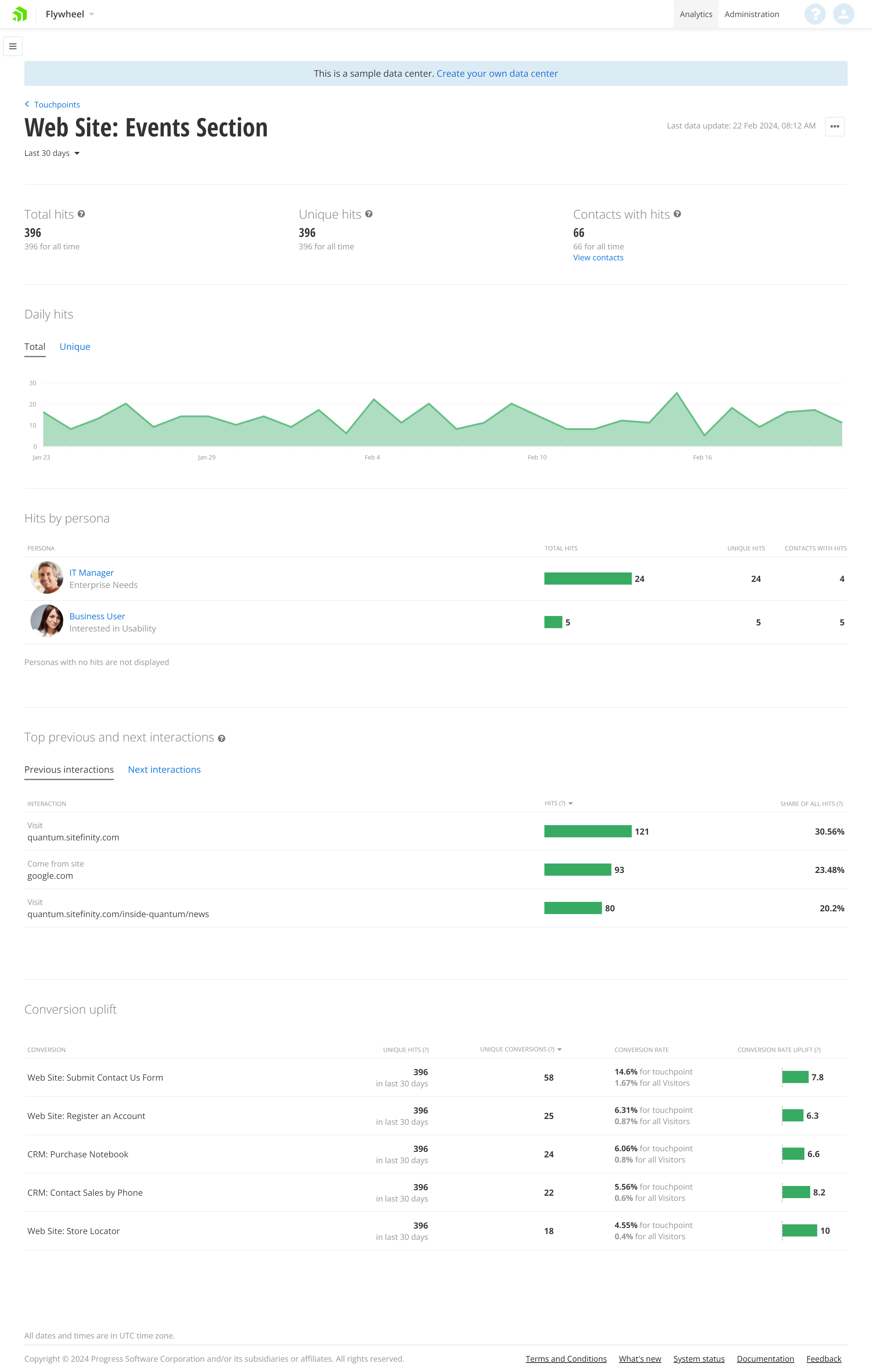 If your goal is to reach a conversion, then touchpoints are the pieces of content that encourage a user to get there. In the simplest form, a touchpoint can be a page, a blog post, or video.
If your goal is to reach a conversion, then touchpoints are the pieces of content that encourage a user to get there. In the simplest form, a touchpoint can be a page, a blog post, or video.
One excellent capability of Sitefinity Insight is that you can also consider a grouping of similar content to be a single touchpoint. For example, you may have a collection of case studies or a blog with many posts that share the same theme. Individually, one of these resources may not have much influence. But when analysed together you discover there is impact.
You can access tracked touchpoints from the left menu. However, you’ll gain more appreciation for this concept by looking at the conversion you recently setup. You may need to wait for conversions to happen. If so, check your conversion report again in another day or two. You are looking for some information to be on the “Uplift by touchpoints” report.
Your list of touchpoints will likely contain a handful of pages on your website. At the moment, these are auto-discovered touchpoints. Sitefinity Insight is showing you content that has been identified as part of a user journey resulting in your conversion. You can formalize what you want to pay attention to by using the utility menu in the actions column of this table (the button with the three dots) to “Start tracking”.
When you create a touchpoint this way, you need to save it with a unique name. A few moments later a unique report is generated for that touchpoint. From here you can further refine your touchpoint if you want to adjust the rule as we suggested a moment ago. You don’t have to do that, but it can be useful. Again, click the utility menu on the touchpoint page and choose “Edit touchpoint”. Adjust and refine the rules from here if you want.
When you formally track touchpoints, you get a full report like what you can now see. Data should be visible to help you understand if this is content that is relevant to your persona audience and influencing the completion of your conversion. All of your touchpoints can be accessed and reviewed from the left menu.
Building Momentum
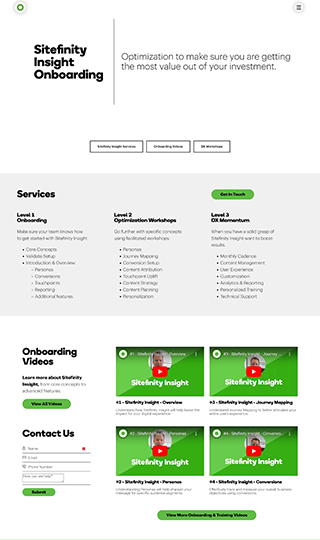
The exercise we just walked through helps reveal the power of Sitefinity Insight, highlighting the following benefits:
- Audience specific engagement reports (Personas).
- Goals measured and analyzed for effectiveness (Conversions).
- Understanding how your content is supporting your goals (Touchpoints).
Sitefinity Insight is a powerful tool that helps you understand and optimize your digital marketing strategy. The system enables you to deliver personalized and engaging experiences to your visitors and contacts to achieve your business goals. With the support of this tool you can plan, execute, and improve your digital marketing campaigns, content, and personalization efforts.
The information we have just walked through in this exercise is just an introduction to the features and benefits of Sitefinity Insight. There is much more that you can do with this powerful tool to enhance your digital marketing strategy and results.
Sitefinity Insight offers many other features that can help you gain deeper insights and take smarter actions. For example, you can use the lead scoring feature to identify and prioritize your most qualified and engaged prospects. You can also use the integrations feature to connect Sitefinity Insight with other tools and platforms, such as other websites, Salesforce, or email marketing systems.
If you are interested in learning more about Sitefinity Insight and how it can help you improve your digital marketing performance, please get in touch. At Flywheel Strategic, we can provide you with onboarding services or health checks for Sitefinity Insight. This is a great opportunity to get started with the tool or to optimize your existing setup and discover how it can help you achieve your specific business goals. You can learn more about these services here: